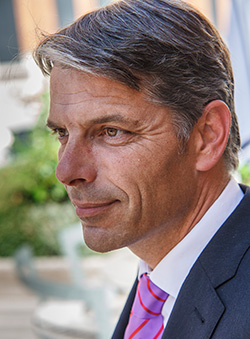The recent European Council acknowledged the importance of hybrid warfare for EU Member States. In this interview we address the topic with EDA project officer Axel Butenschoen.
 | Axel Butenschoen is Project Officer for Capability Development Plan within the European Defence Agency. |
- How does hybrid warfare differ from “conventional” warfare? Is it really something new?
From an academic point of view we have to state that a broadly accepted definition of “hybrid warfare” does not exist yet. One reason could be that by nature the characteristics of this new type of threat is evolving nearly on a daily basis. However, amongst analysts there are common elements describing this phenomenon of new threats by “violent threats that are simultaneously carried out by state- and non-state actors along all conventional and unconventional lines of operation within a not exclusively military but also diplomatic, information and economic dimensions of conflict in order to achieve a political goal”. From my perspective all the individual elements, for example information warfare, cyber-attacks, conventional military aggressions and destabilisation operations are individually well known but the synchronized, combined approach adds a new dimension to our understanding of aggression.
- Why does hybrid warfare matter to EU Member States?
During the past years Europe’s security has been challenged significantly by this new dimension of conflicts at its eastern and southern borders. The paramount question now is how to counter these so called hybrid threats? Are EU Member States prepared for this challenge and do we have the adequate set of tools in our toolbox? How can EU instruments also support Member States? During the recent European Council, Heads of States and Governments acknowledged the importance of the subject and it can be expected that the EU global strategy on foreign and security policy, to be delivered in 2016, will address the hybrid dimension accordingly.
- What role could the Agency play in supporting its Member States’ counter hybrid capabilities ?
First of all I believe that exclusive counter-hybrid capabilities do not exist. As explained earlier the new character posed by Hybrid threats is the coordinated combination of more or less existing capabilities by potential adversaries. Consequently, any kind of response also requires a comprehensive but effective approach. In this regard the EDA will not enter into an academic discussion but focus on the military capability dimension.
Together with Member States and other relevant stakeholders we will conduct a series of subsequent assessments in order to identify the implications of Hybrid warfare for defence capability development in Europe. The results will be presented to Ministers and Capability directors for their consideration; it will support Member States’ efforts in countering Hybrid threats. At the same time the objective is to stress test existing Priorities and identify possible need for amendments.
This EDA activity will also supplement other initiatives carried out in this context, for example within the European External Action Service, in charge of preparing a joint communication on hybrid warfare. At this stage one cannot anticipate the results but the key question: “Are European Member States prepared to counter hybrid threats?” may be answered with findings in line with “We have adequate capabilities in place but we need to rethink the way we deploy in a more coherent, comprehensive way”. Also such possible outcomes would be of added value and could trigger effective follow-on activities so that Europe stands ready for these new threats.
More information